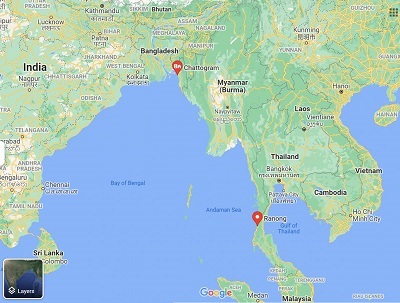Context
The Bay of Bengal presents a unique opportunity for Bangladesh and Thailand to enhance their bilateral trade through a shared maritime space. The concept of a Chattogram-Ranong connection, facilitating direct shipping, could bring substantial economic benefits to both nations. The coastal geographies of Bangladesh and Thailand necessitate efficient port connectivity for economic growth. Bangladesh, situated to the north of the Bay of Bengal, and Thailand, on the eastern coast of the Andaman Sea, have the potential to leverage their maritime locations for mutual advantage. Recent discussions during Bangladeshi Prime Minister Sheikh Hasina’s visit to Bangkok have rejuvenated the idea of establishing a direct shipping line between Chattogram Port in Bangladesh and Ranong Port in Thailand, building on an MoU signed in December 2021.
Enhancing Port Connectivity
Chattogram Port, located in southeastern Bangladesh, is the principal maritime gateway for the country, handling over 90 percent of its sea trade. As the busiest port in the Bay of Bengal and a significant global player, being listed in Lloyd’s top 100 ports worldwide, it plays a crucial role in the region's commerce. Ranong Port, Thailand's only port along the Andaman Sea, connects to the Bay of Bengal, enhancing Thailand's maritime reach. Thailand is actively developing Ranong to improve connectivity with the littorals of the Bay, particularly with India’s Andaman and Nicobar Islands.
Currently, Bangladesh’s exports to Thailand undergo transshipment through Singapore, Malaysia’s Port Kelang, and Sri Lanka’s Colombo Port, taking approximately 10 days. Establishing a direct shipping link would reduce transportation time to three days and decrease shipping costs by around 30 percent. This route could be efficiently serviced by local private companies operating bulk carriers and container ships with a 7-meter draught and a capacity of 10,000 tonnes or 20-foot equivalent units.
Perks of Direct Shipping
The establishment of a direct shipping line between Chattogram and Ranong promises to boost both trade and tourism between Bangladesh and Thailand. During Prime Minister Hasina’s visit, a letter of intent to begin negotiations for a Free Trade Agreement (FTA) was signed, aimed at overcoming the existing trade deficit. In 2022, Bangladesh exported goods worth $83 million to Thailand, while imports reached $1.17 billion. An FTA would help balance this trade disparity and facilitate greater commercial exchange.
Additionally, the direct shipping route would eventually support passenger services, benefiting the tourism sector—a significant area of cooperation between the two countries. Thailand is a favored destination for Bangladeshi tourists and medical tourists, with 140,000 Bangladeshis visiting in 2019, including 4,300 seeking medical treatment. This influx contributed approximately $182 million to the Thai economy. Three MoUs were signed during PM Hasina’s visit to enhance tourism, visa exemption for official passport holders, and customs cooperation. Future tourism initiatives, such as promoting the Buddhist circuit, could further increase tourism exchanges.
Strategic Advantages
Beyond trade and tourism, the Chattogram-Ranong shipping link offers strategic advantages for both countries. For Thailand, this connection enhances trade opportunities with Nepal, Bhutan, and Northeast India, which are part of Chattogram Port’s hinterland. Bangladesh, eager to strengthen ties with Southeast Asia, sees this connection as crucial. Thailand’s support for Bangladesh’s bid to join the Mekong-Ganga Cooperation Forum and gain Sectoral Partnership status with ASEAN is vital for addressing regional issues such as the Rohingya crisis.
The direct shipping route also provides Bangladesh potential access to the Pacific Ocean via Thailand’s Landbridge project, which connects the Andaman Sea with the Gulf of Thailand through highways and railways. This corridor facilitates the movement of goods and people between the Indian and Pacific Oceans without navigating the congested Strait of Malacca. If operationalized, the Landbridge will significantly boost commerce in the Bay of Bengal, complementing the Chattogram-Ranong link. The BIMSTEC Master Plan on Connectivity (2022) envisions creating direct shipping links between Thailand’s Ranong Port and the ports of Chennai and Colombo, aligning with this initiative.
Diplomatic Caveats
Despite the many benefits, the implementation of the direct shipping route faces diplomatic challenges. Myanmar’s political instability, especially in the coastal province of Rakhine, which lies midway between Chattogram and Ranong, poses a significant hurdle. Ongoing conflicts between ethnic communities and the military Junta have delayed the project since discussions began in 2016. Diplomatic efforts will be crucial to address these issues and make the shipping link functional.
Additionally, China’s increasing presence in the Bay of Bengal adds another layer of complexity. Chinese investments in Bangladesh and interest in the Thai Landbridge project, a potential alternative to the Malacca Strait, are significant. In February 2024, the Asian Infrastructure Investment Bank expressed interest in developing the Landbridge, aligning with China’s Belt and Road Initiative (BRI). Both Bangladesh and Thailand are BRI members, and the direct shipping link between Chattogram and Ranong could become a key component of this initiative. This prospect may concern India and other Indo-Pacific nations, wary of China’s expanding influence in the region. Balancing economic aspirations with diplomatic sensitivities will be a test of Bangladesh and Thailand’s diplomatic prowess.
Conclusion
As Bangladesh aims for economic prosperity to transcend its Least Developed Country (LDC) status by 2026 and achieve middle-income status by 2031, the Chattogram-Ranong shipping link holds high commercial value. For Thailand, this route offers an opportunity to diversify its trade beyond China and strengthen commercial ties with South Asia. The success of the shipping link depends on integrating it into the Bay of Bengal’s regional trading network while balancing economic goals with diplomatic challenges. By addressing these issues, Bangladesh and Thailand can unlock the full potential of their shared maritime space, fostering economic growth and regional cooperation.
|
Probable Questions for UPSC Mains Exam
|
Source - ORF







